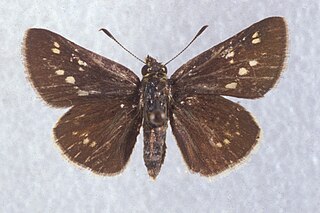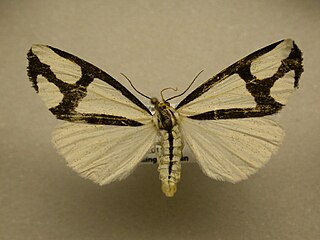
Haploa is a genus of tiger moths in the family Erebidae. The genus was erected by Jacob Hübner in 1820.

Apantesis is a genus of tiger moths in the family Erebidae first described by Francis Walker in 1855. They are found in North and Central America.

Cycnia is a genus of tiger moths in the family Erebidae. The genus was erected by Jacob Hübner in 1818.

Haploa clymene, the Clymene moth, is a moth of the tiger moth subfamily - Arctiinae, tribe Arctiini. The species was first described to Western science by Peter Brown in 1776. It is found in eastern North America.
Kodiosoma is a monotypic moth genus in the family Erebidae. Its only species, Kodiosoma fulvum, is found in Arizona, Nevada and California. Both the genus and species were described by Richard Harper Stretch in 1872.

Leptarctia is a monotypic tiger moth genus in the family Erebidae described by Stretch in 1872. Its only species, Leptarctia californiae, was described by Francis Walker in 1855. It is found in western North America, from New Mexico and Colorado to California and north to British Columbia. The habitat consists of open forests, meadows and clearings in the mountains.

Hypenodes is a genus of moths of the family Erebidae erected by Henry Doubleday in 1850.

Catocala junctura, the joined underwing or Stretch's underwing, is a moth in the family Erebidae. The species was first described by Francis Walker in 1858. It is found throughout temperate North America, ranging from New York and Pennsylvania west to Montana, Colorado, Oklahoma, Arizona, and into Texas, and north to southern Illinois, extreme southern Alberta and Saskatchewan; it has also been recorded west of the Rocky Mountains from California and south-eastern British Columbia. It is typically found near water, where the food plants of its caterpillar larvae grow plentifully.

Haploa lecontei, or Leconte's haploa, is a moth of the family Erebidae. The species was first described by Félix Édouard Guérin-Méneville in 1832. It is found in North America from Nova Scotia to Georgia, west to Manitoba through Arkansas.

Amblyscirtes reversa, the reversed roadside skipper, is a butterfly of the family Hesperiidae. The species was first described by Frank Morton Jones in 1926. It has a scattered distribution from south-eastern Virginia, south to northern Georgia. It is also found in southern Mississippi and southern Illinois.

Cisthene plumbea, the lead-colored lichen moth, is a moth of the family Erebidae. The species was first described by Richard Harper Stretch in 1885. It is found in eastern North America, from southern New Jersey south to northern Florida, west to Wisconsin and Texas.
Haploa colona, the colona moth, is a moth of the family Erebidae. The species was first described by Jacob Hübner in 1802. It is found from south-eastern Virginia south to Florida and west to Texas.

Ctenucha brunnea, the brown ctenucha or brown-winged ctenucha, is a moth of the family Erebidae. The species was first described by Richard Harper Stretch in 1872. It is found in the US from central to southern coastal California.

Estigmene albida is a species of moth in the family Erebidae. It was described by Richard Harper Stretch in 1874. It is found in the United States from Montana to South Dakota, south to New Mexico and Arizona. It is also found in Mexico, Costa Rica and Guatemala.
Gnophaela discreta is a moth of the family Erebidae. It was described by Stretch in 1875. It is found in Mexico, Arizona and California.
Apantesis obliterata is a moth of the family Erebidae. It was described by Richard Harper Stretch in 1885. It is found in Russia, Mongolia and North America. The habitat consists of grasslands.

Haploa contigua, the neighbor moth, is a moth of the family Erebidae. It was described by Francis Walker in 1855. It is found in eastern North America, from Quebec to the mountains of Georgia and west to South Dakota, Arkansas and Mississippi.

Apantesis proxima, the Mexican tiger moth, is a moth of the family Erebidae. It was described by Felix Guérin-Méneville in 1844.
Arctia yarrowii, or Yarrow's tiger moth, is a moth of the family Erebidae. It was described by Richard Harper Stretch in 1874. It is found in North America from Hudson Bay to British Columbia and northern Arizona. The habitat consists of barren rocky fellfields and slides above the timberline. These moths are also found in the Pacific Northwest.













